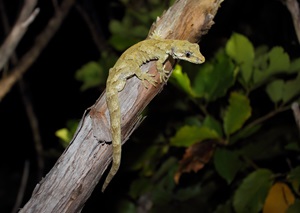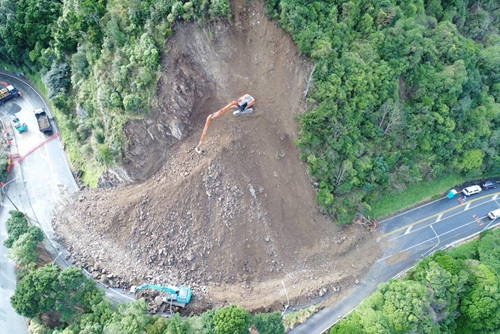It is thought that a range of lizard species populate the area, including some that are considered to be at risk or in decline.
Wellington City Council is set to carry out major strengthening work in Ngaio Gorge to make this key transport route stronger and more resilient, following landslides in July 2017.
Physical works that are expected to take two years include building retaining walls, widening and realigning the road, drainage and slope stabilisation.
Stabilisation of the slope will require the removal of vegetation, which is of potential value for native lizards.
Leading the lizard relocation is ecologist Michiel Jonker, Principal Environmental Scientist of engineering firm AECOM.
“Lizards likely to occur in the project area include the copper skink, northern grass skink, and Raukawa gecko, as well as three ‘At Risk-Declining’ species – the ornate skink, barking gecko, and ngahere gecko (pictured).”

A herpetologist, which is an expert in reptiles and amphibians, will survey the area to identify where the lizards are.
Each animal will be collected into individual breathable cloth bags to be transferred to their new home, with measures to minimise the risk of overheating and stress during the process.
The lizards are to be relocated to Trelissick Park, which is opposite the worksite, and depending on how many lizards are found, some may also be transferred to Otari-Wilton's Bush.
The relocation of the lizards was initially scheduled to take place in March 2020, however it was postponed because of the lockdown. It is now planned to go ahead in October, but this may change depending on Covid-19 restrictions.
Michiel says when it comes to moving the lizards, temperature is a key consideration.
“Lizards are less active during winter and are therefore at greater risk of injury and death during vegetation removal. For this reason, vegetation clearing should only occur during warmer months.”

He says all the vegetation that will be impacted by the stabilisation project will be clearly marked and potential habitat inspected for lizards, prior to its removal.
“All removed vegetation will carefully be inspected for the presence of lizards. Native lizards will be captured by the specialist and scientific data will be collected, including species, sex, length, weight and photographed. Lizards will be moved to suitable habitat next to disturbed areas or predetermined areas off-site.”
Michiel says native species are protected under the Wildlife Act and many of New Zealand’s lizards are considered ‘At Risk’ or ‘Threatened’. He says it is difficult to say how many lizards will be located and moved.
Council Team Leader Structures Faiz Tawfeek says the slope stabilisation works aim to provide a permanent solution for this critical transport route, improving its safety and accessibility. He says the lizards had certainly added a unique aspect to the project.
Council Structures Engineer Sarath Amarasekera says the herpetologist will visit the site twice, first surveying for lizards in the area where three retaining walls are to be erected along the edge of the new road alignment, and then where the slope stabilisation work is taking place.
He says these works are in line with Council’s value of 'Mana Tiaki: We care for our places. We consider the impact of what we do'.